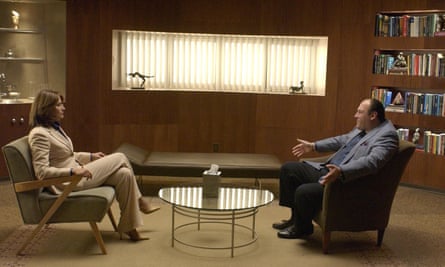This is the age of the fictional psych, instantly canonised in the person of Tony Soprano’s analyst, Jennifer Melfi, beautifully developed by Gabriel Byrne with In Treatment, and given a shonky Netflix-over by Naomi Watts in Gypsy.
When The Sopranos came out, the richness of the territory was astonishing; I sometimes wondered not why it hadn’t much been done before, but why all TV series didn’t do it, why President Josiah Bartlet wasn’t also in therapy, and The Wire’s Stringer Bell, and Breaking Bad’s Walter White. It was such a stunningly obvious way to zoom in and out of character, develop metaphor – it was as if someone had invented a new kind of camera.
Yet as the precinct of the drama moves away from the subject and towards the psychoanalyst, the focus tightens on therapy itself. What does it tell us, dramatically? Do the exigencies of plot pull with or against those of authenticity? Is it even possible to get it right? Analysis is like secular Judaism, everyone thinks they know something about it because of Woody Allen, but it’s unclear how much real expertise this bestows. We need to know, in short, what the shrinks think.
A word, first, on Gypsy. Watts plays an analyst with a handsome husband, a spunky daughter, supportive colleagues and a beautiful home. It’s directed by Sam Taylor Johnson, and has that distinctive echoey-ness of her Hollywood career (she also directed the first Fifty Shades). She seems interested by a topic, BDSM, say, or psychoanalysis, but from a huge distance, as if she’s watching it from a plane, not so much detached from as unsullied by its details.

Watts has a lusty and uninhibited marital sex life but still isn’t happy. Anyway, her character, Jean Holloway, drinks bourbon (code for imminent breakdown, except when a man does it; then it’s code for “handsome rascal”) and develops a fixation on Sidney, the ex-girlfriend of one of her clients, which pitches her into an ethical crisis, as she’s sniffing around the coffee bar, looking for the bewitching girl and so is her client. Jean has, as they say, become unboundaried.
Philippa Perry, psychoanalyst and author of Couch Fiction and How to Stay Sane, examines the premise for a second. “Let me just do my evil cackle here … nope.” You would never think about the client outside their appointment, let alone chase down their obsessions? “The relationship is that you couldn’t give the sort of attention that a patient requires if you had to live it longer than 50 minutes. It’s concentrated attention, concentrated listening. That’s why you have your boundary of time. It’s like having a baby, you’re open to their every nuance and twitch, and you let it affect you. It’s just exhausting.”
Susie Orbach, psychotherapist, author of Fat is a Feminist Issue and creator of the wonderful Radio 4 series In Therapy, in which actors reproduce therapeutic scenarios, has a slightly different take: “People do become big figures in their therapists’ lives. You live with them for many, many years, and they do take up residence inside of you, emotionally.” But that just nixes the Gypsy plot from another angle: a therapist thinking about a client in that way would be unlikely to try to steal his girlfriend, even if they had split up.
It’s possible that the relationship between the therapist and the client has to be amped up, its boundaries have to be broken, in order to force a dramatic situation. Martha Crawford has worked as a psychotherapist for 22 years, as well as working with actors and writers to explore the psychological continuity within characters. She says writers do sensationalise. “They make it more lurid, more ‘active’ and more ‘dramatic’ than it actually is: films like Analyze This and What About Bob, and the boundary violations – a sexual relationship in In Treatment – all depict gross malpractice as if it were normative practice.”
“I also think,” Crawford continues, “there is a powerful archetype (here is where I get a bit Jungian) of the Wounded Healer – which speaks to the ways that psychotherapists must know and be continuously aware of their own wounds to be of use to others: that surfaces in these narratives.” Jennifer Melfi, of course, never breaks a boundary, except when she considers getting Tony to take a hit out on the man who raped her, but according to Perry, their relationship itself is a code breach. “I loved her,” Perry says, “because she was so flawed. She was out of her depth.”

What would a good analytical session have looked like, though, with Tony Soprano? “Remember when Carmela went to a therapist, and he said, ‘I’m not taking your money, because it isn’t ethically obtained’? That boundary was incredible for her. It was actually quite therapeutic.” The only way to treat Tony Soprano would be to not treat him. Though, parking that for a second, Crawford finds echoes of Melfi/ Soprano in her own career. “Early on, I worked in forensic mental health with many clients who had a history of violence. I remember a dream that Melfi had of a giant, violent, snarling guard dog that she had on a leash that mirrored a counter-transferential dream I’d had myself.”
Probably where In Treatment misses the mark (apart from the fact that you’re really not supposed to shag your clients) is in the personality of Gabriel Byrne, his sheer looming presence. Orbach recalls: “Donald Winnicott did these incredible broadcasts in the 50s, and he spoke to mums and he broadcast that on the radio. And that was very important, but that was [as a profession] as far as we went. We didn’t have a cult of personality and quite right, too. They’re not coming for you, they’re coming for your ability to listen, and your capacity to think, and have a capacious heart, and stick with them.”
Byrne actually ascribed the success of that show, in an interview I did with him in 2012 (and only mention now because it was, politically, so prescient) partly to the rise of the box set. You need acres of time to get to the truth of a psychoanalytical relationship, and time – until we started watching series in six-hour chunks – simply didn’t come in acres. But also, the neurotic zeitgeist: “I always thought the success of the show was symptomatic of something bigger; the more disenfranchised and placeless people feel, the more they need to be listened to. People have a tremendous need to be heard, and that’s true in their emotional lives, but it’s also true in the world of politics. You hear it in America especially, but here as well, this feeling that nobody is being heard.”
One final feature of Gypsy gets, I think, to the heart of why therapy is so fascinating and so hard to render. All Jean Holloway’s sessions are very boring. “My clients never bore me,” Perry says, “and I’ll tell you why. If someone’s boring you, it’s because they’re not saying what’s on their mind. They’re not giving you a part of them. If I’m not engaged, I’ll say, ‘It’s odd, because I keep drifting off. Is there something you’re not talking about?’”
What looks like an easy thing to hang a plot on – a therapist’s couch – is actually the hardest thing imaginable, a room in which no action can happen, but everything must scintillate.

Comments (…)
Sign in or create your Guardian account to join the discussion